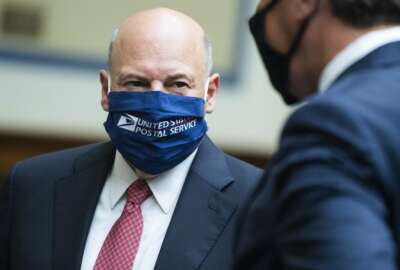An update from the Postal union at center of the test kit delivery program
A gambit by the Biden administration to mail COVID test kits to every household, has highlighted a part of the Postal Service most people don't see. The mail and...
Best listening experience is on Chrome, Firefox or Safari. Subscribe to Federal Drive’s daily audio interviews on Apple Podcasts or PodcastOne.
A gambit by the Biden administration to mail COVID test kits to every household, has highlighted a part of the Postal Service most people don’t see. The mail and packaging sorting and logistics that takes place before items get onto the little white trucks. Joining the Federal Drive with Tom Temin with an update, the president of the American Postal Workers Union, Mark Dimondstein.
Interview transcript:
Tom Temin: Mr. Dimondstein, good to have you on.
Mark Dimondstein: Thanks so much for having me, Tom.
Tom Temin: Picture for us what is going on here because your folks sort and otherwise direct packages all the time to the trucks. What’s new about this?
Mark Dimondstein: In the broad stroke, what’s going on is the postal services, again, is a public agency and universal service to everybody’s address no matter who we are, and where we live. We’re taking on a new project for the American people. And we’re very proud of that. And we’re enthusiastic about it. Now, very specifically, the Biden administration is planning to send free test kits, COVID test kits, which we certainly support, it’s an ongoing public health crisis, but free test kits and everybody’s home who asks. So that could be potentially 120, 130 million orders. So then there’s the challenge of how to get those orders to the people. And the Postal Service plays the role. Once the product gets to the Postal Service, postal workers can only do our part, when the test kits get to the post office, we’re not responsible for that. But once the test kits get there, we set up a whole program where there’s going to be packaging, labeling, and, of course, the postage, and then going into the mail stream. So we’ve agreed with the Postal Service to allow them to keep a lot of temporary holiday help to be focused on this project, we don’t want the project to take away from your regular mail, and that process and what should be timely delivery there. So there’s gonna be thousands of people just working on this project, the test kits come in, they’re going to get bubble wrapped, they’re going to be put in envelopes. And they’re going to go right into the mail stream.
Tom Temin: All in one place like Oklahoma or something?
Mark Dimondstein: The other thing the Postal Service did that I think is good for this project is they’re doing it at 43 sites around the country. So it’s not like if you order a test kit in Los Angeles, it’s going to be packaged in Washington, DC and then have to go across the country. It’s going to be directed to those specific areas that will be a closer radius to where they are going.
Tom Temin: Now people that ordered with the website as I did, and it took two seconds. And I had a affirmation and I got an email affirmation from the Postal Service. What is the linkage between say, a given address and a given order of four boxes of four test kits? How does that get into those 43 centers, so that that can be coordinated with the labeling and packaging?
Mark Dimondstein: Well, that’s the world of information technology, they have it set up where if you order from a particular ZIP code, they know what processing area to send it to that’s closer in that radius. And once the post office is getting the product, so far, it’s going pretty smoothly. Very interesting, Tom, in the first six hours, just to show you the demand and the need of the people in the country, in the first six hours that the website went up, approximately 45 million orders were placed. So obviously that’s not going to be processed overnight. But also the test kits aren’t necessarily there yet. They’re coming in hourly and daily. But they’re not necessarily all there yet.
Tom Temin: And is there some communication to the people making the test kits, the companies as to what quantities roughly they need to deliver to which of the 43 centers?
Mark Dimondstein: I am sure that’s going on behind the scenes, because it would not work without us. I think there is communication between the administration, postal management, the information technology and the platforms that are used. So yes, they have to be able to know where to deliver those sites based on how many orders. And they already have a pretty good feel for where the orders are coming in, in greater quantity due to the population of those areas.
Tom Temin: And I understand this work, and you indicated, it can’t be done simply with a standard permanent workforce of the APWU and there are temps coming in. What is their status with respect to the union and to the Postal Service?
Mark Dimondstein: Well, so look, it definitely is a temporary project, much like the peak holiday season is. But in every peak holiday seasons, a certain percentage of the temporary workers do end up getting hired as the post office has turnover. So some of them will probably have new opportunities going forward, but certainly not the majority.
Tom Temin: And at this point in time, you know, say the first week in February, last days of January has that activity actually ramped up are you awaiting the kits themselves at this point?
Mark Dimondstein: No, it is, I think ramping up is a good word right now, Tom, because part of what’s ramping up is getting the test kits supplied from the manufacturers to the post office that we are not responsible for. So there’s a ramp up there. But my understanding is their goal is to move a couple million, at least a couple million test kits a day. They’re staffing for that, we have the setup for that. So it’s really a question of getting the product into the system, so the post office and postal workers can do our job.
Tom Temin: We’re speaking with Mark Dimondstein. He’s president of the American Postal Workers Union. And you have been meeting regularly with Postmaster General Louis DeJoy. How’s that going? And are you mostly seeing eye to eye on this whole project and things in general?
Mark Dimondstein: Well, those are two different questions, Tom. Things in general, yes, and no. We have some serious disagreements. We did not agree with lengthening the time of mail based on longer distance. We think that the law says that people that apply postal services to the people and country it says prompt, efficient, and reliable services. So we completely disagreed with that we made our voices heard we organized with the public. And we’ll try to continue to work in ways going forward to try to restore quicker and better service. On the other hand, on a project like this, we’re very much aligned. We think it’s a great opportunity. There’s a great need for the people in the country. And it’s a great opportunity, once again, to underscore just how important the mission of the Postal Service is to the people of the country. And we saw that, throughout the whole pandemic. Where, even in these trying times, just like other essential workers, stressful trying and dangerous times, postal workers have remained really dedicated to the mission. We say, without any disclaimers, we say that truly our folks and all the postal workers are postal heroes out here. So we are very much aligned on this. We’re aligned on things like maintaining six day delivery. But we certainly don’t want to see any reduction in service. And we don’t want to see any reduction in hours of postal operations on the retail side where you would go get your stamps and write your post office boxes and buy your money orders, etc. In general, what we do is we stick with the issue, and I call the Postmaster Generals and the Board of Governors, they have a 10 year plan. We call it the good bad and the ugly, which means it’s got good, we’re going to work with the good and with the bad we’re going to work against it and try to make it better.
Tom Temin: Just to play devil’s advocate, though, I think some of the measures that DeJoy has made have, for the first time, started to reverse the annual financial losses, the hollowing out of the Postal Service’s balance sheet. And so if say it takes an extra day from Washington to California, or from Seattle to Miami, and that would, on the other hand, make the whole system more financially sound, shouldn’t that be a pretty good trade off?
Mark Dimondstein: Well, we don’t see that. We certainly want to work to make the system financially sound, and another area where our union and postal management are aligned, is in postal legislation to help write the finances, particularly the, what we call the defunding of the public postal service from 2006, where law passed called the Postal Accountability Enhancement Act. And that was the law that forced the post office to pre-fund retiree health benefits, not retirement benefits, retiree health benefits 75 years into the future for workers that didn’t even work at the post office yet. And in some cases weren’t even born yet. This legislation that we’re working on, will undo that really draconian and erroneous, unfair burden that no other agency or company has to do. But the slowing down of mail does not write the financial ship. In fact, we think that it drives away needed revenue, because if people can’t get the service that they need, from the Postal Service in a timely way, then they’re going to go elsewhere. So we certainly want to work together to right the ship. But we don’t think slowing down and mail does it. We actually think it does the opposite.
Tom Temin: All right. Well, as someone who still writes letters by hand and put stamps on them for first class, I can understand that point of view. And of course, I can remember when daily delivery was twice a day, and that’s really going back some years.
Mark Dimondstein: I think you and I are both showing our age.
Tom Temin: I’m afraid so. And just a final question, how has the COVID and the infection rates and all the rest of that apparatus affected the APWU specifically? Because your employees your folks are close together in an enclosed facility versus save the drivers and the carriers who are mostly out there alone interacting with biting dogs and recalcitrant mailboxes.
Mark Dimondstein: Look, it’s been a huge challenge for us, just like all workers, and all people. We were able to put some things into place very early that made the workplace as safe as possible in terms of PPE, masking, social distancing, cleaning chemicals, cleaning protocols. But it’s still been hard, we have, just the other day, we’ve had over 20,000 postal workers, not just the people that we represent doing sortation, but all postal workers as a whole. And that’s just the official quarantine, those of people who are sick in or have been in direct line of somebody, it was. There are more people that can’t come to work, because they’re not feeling well. And they’re going to get tested. Or they are not feeling that well, and they want to protect the loved one, or they don’t want to come to work and possibly expose somebody.
So it’s had a huge impact on the workforce. And it also has had a significant impact on service. And I think the people in the country understand that and appreciate that they want their postal services, they need it, they rely on us, they trust us. I mean that 90% of the people in the country have a favorable view of the public Postal Service, higher than any other agency and really, in many, in most cases, higher than any company. Certainly a higher rating, than my grown children would rate their father and their mother probably, right? 90% unheard of. So, look, it’s taken a lot of patience and appreciation on the part of the public. But certainly the public doesn’t want us to be sick, but they also want their service. We also allow the Postal Service time to hire some temporary people to make up for the impact of COVID on the staff. So we’ve done everything we can to try to keep things moving. For the people, we’re not in complete control, management’s made some decisions that is undermined service, we opposed. But whatever we’re facing postal workers are still out there doing the best we can to serve. And the test kits, are just to me, it’s a wonderful example of just what it means to have a public institution because a private carrier, on the package side, they’re going to go where they can make money. They’re not going to go to every address, no matter who we are and where we live.
Tom Temin: Mark Dimondstein is president of the American Postal Workers Union. Thanks so much for joining me.
Mark Dimondstein: Thanks so much for having me, Tom. I hope all the listeners are safe. Be well, and a little belated Happy New Year to everyone.
Copyright © 2025 Federal News Network. All rights reserved. This website is not intended for users located within the European Economic Area.
Tom Temin is host of the Federal Drive and has been providing insight on federal technology and management issues for more than 30 years.
Follow @tteminWFED






